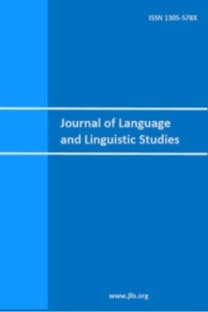An autosegmental analysis of the derivation of weak active participles from triconsonantal verbs in modern standard Arabic
Autosegmental phonology;, MSA, corpus-study; weak stems; APs
___
Abd Al-Ghani, A. (2010). Ɂassarf Ɂalka:fi: [sufficient morphology]. Cairo: da:r Ɂttawfi:qijjah liltura:θ.Abdo, D. (2008). ʔabḥa:θ fi: ʔalkalimah wa Ɂadʒumlah [studies in the word and the sentence]. Amman: da:r Ɂalkarmil.
Abdo, D. (2010). dira:sa:t fi: cilm Ɂaswa:t Ɂalcarabijjah [studies in Arabic phonology]. (VOL 2). Amman: da:r dʒari:r.
Abu Salim, I. (1988). On the phonological status of /Ɂ/ in Classical Arabic. Albahth, 36, 71-79.
Abushunar, M. and Mahadin, R. (2017). An autosegmental analysis of Arabic passive participle of triliteral verbs, Arab Society of English Language Studies, 8, 252-267.
Al-Faxiri, S. (1996). tasri:f ɁalɁfca:l wa Ɂalmasa:dir wa Ɂalmuʃtaqqa:t [the inflection of verbs, verbal nouns and derived forms]. Cairo: casmi liɁannaʃir wa Ɂattwzi:c.
Al-Nuri, J. (2007). cilm ɁalɁaswa:t Ɂalcarabijjah [Arabic phonology]. Palestine: dʒa:micat Ɂalquds Ɂalmaftu:hah.
Al-Raajihi, A. (1984). Ɂattatbiiq Ɂassarfi: [morphological application]. Beirut: da:r Ɂannahd Ɂalcarabijjah.
- ISSN: 1305-578X
- Yayın Aralığı: Yılda 4 Sayı
- Yayıncı: Hacettepe Üniversitesi
Challenges of translating neologisms comparative study: Human and machine translation
Awadh Nasser Munassar AWADH, Khan Ansarullah SHAFİULL
Native or non-native instructors? A case study on foreign language speaking anxiety in EFL classroom
Ceren YENTÜRK, Gülin DAĞDEVİREN-KIRMIZI
Non-native speakers’ attitudes towards the use of short Arabic stories in language classes
Omran Ahmad MUSLEH, Mohamed Abdelrahman IBRAHİM, Abdel Rahman Mitib ALTAKHAİNEH
Salih Kürşad DOLUNAY, Hüseyin KARABUĞA
Riza Alifianti PUTRİ, Ni Wayan SARTİNİ, Muchamad Sholakhuddin AL FAJRİ
Aslı Yaren YÜZGEÇ, Selim Soner SÜTÇÜ
Mete Yusuf USTABULUT, Savaş KESKİN
Evalyn Bonquin ABİOG, Rowena DAVİD
